News
Slavery Then, Slavery Now: Class Connects Slave Trade to Human Trafficking
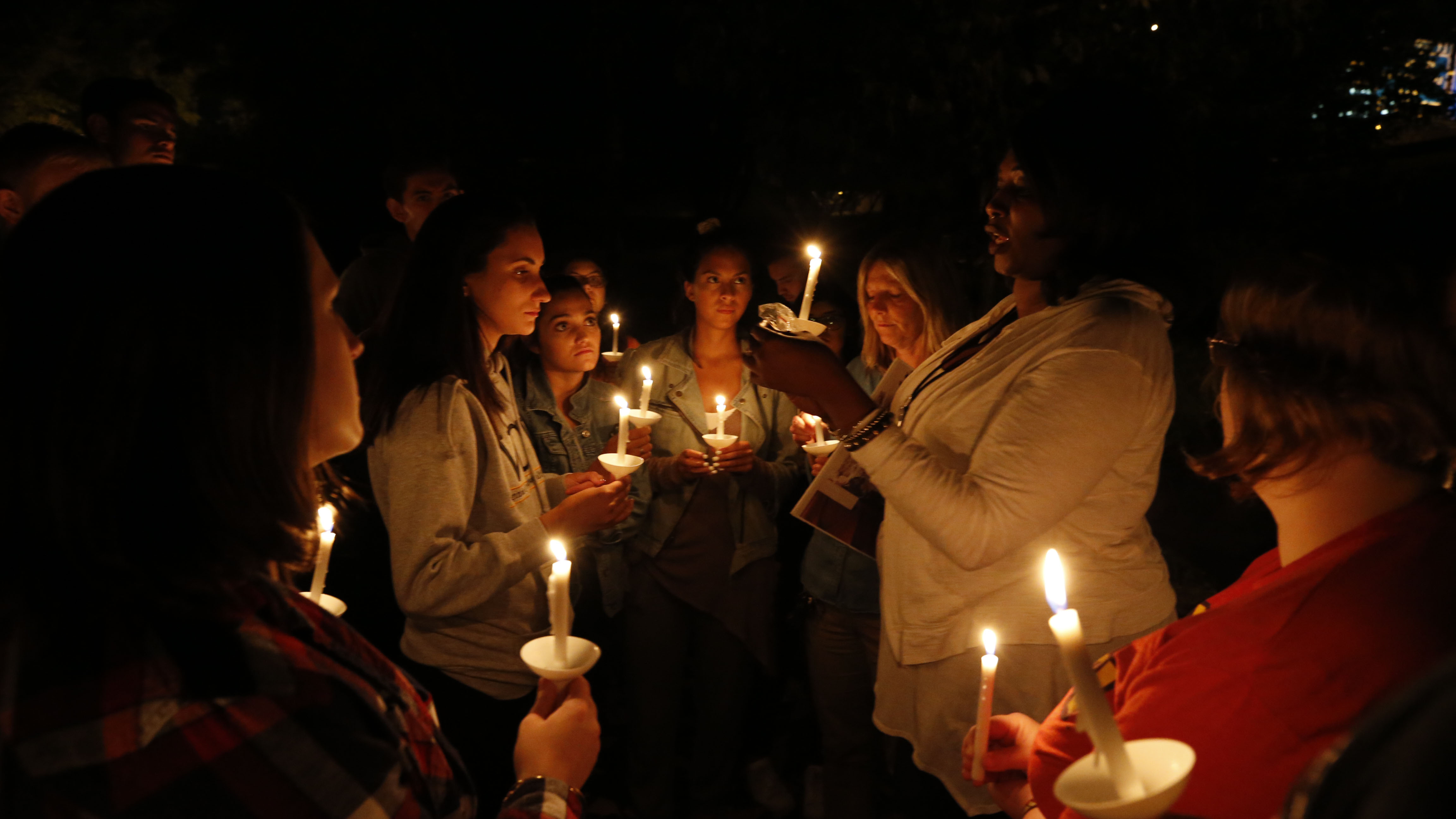
By Tiffany Murray-Robertson
It’s 7 o’clock on a temperate September evening, class time for 19 Wilder School students assembled at Richmond’s famed Libby Hill Park.
The class—future victim’s advocates, law enforcement and security professionals—are members of HSEP 391: Human Trafficking, an experiential learning sequence designed to explore various dimensions of contemporary human exploitation.
The course is led by Maureen Moslow-Benway, an assistant professor of Homeland Security and Emergency Preparedness, and a former counter-intelligence agent whose professional experiences with sex trafficking victims in Southeast Asia inspired its creation.
Moslow-Benway believes in the power of immersive learning, which is why she has combined her personal development funds with an award from VCU’s Division of Inclusive Excellence to get students out of the classroom to experience the historical, physical and psychological realities of human exploitation.
“There is something about being in the field that makes a theoretical concept come alive for students. In this case, that something is Richmond’s extensive legacy of enslavement,” she said. “As odious is that history may be, it represents a kind of continuum between African salves and modern-day victims of human trafficking. I want my students to really mine that connection.”
“There is something about being in the field that makes a theoretical concept come alive for students. In this case, that something is Richmond’s extensive legacy of slavery. As odious as that history may be, it represents a kind of continuum between African slaves and modern-day victims of human trafficking.”
To aid in that effort, Moslow-Benway has designed an interactive curriculum that encourages students to analyze the proximate causes and consequences of human trafficking through literature, film and historic excursions. They also engage with subject matter experts through a combination of service and research projects.
Students in HSEP 391 are encouraged to reflect on—and document—their experiences, enabling them to draw connections between local observations and various global phenomena.
So far, the class has met with a sex trafficking victim and the director of an international organization dedicated to the eradication of child sex trafficking. Last week, they explored the connection between Confederate symbols of oppression and the enslavement of blacks through the Valentine Museum’s walking tour of Monument Avenue.
On this particular evening, they will expand their understanding through an evocative tour of Richmond’s African Ancestral Burial Ground led by Free Egunfemi, a social entrepreneur and the founding director of Untold RVA, a private community improvement organization aimed at documenting missing pieces within Richmond’s racial and ancestral history.
Listen to Free Egunfemi, founding director of Untold RVA, talk about the Wilder School's tour.
Setting the Scene
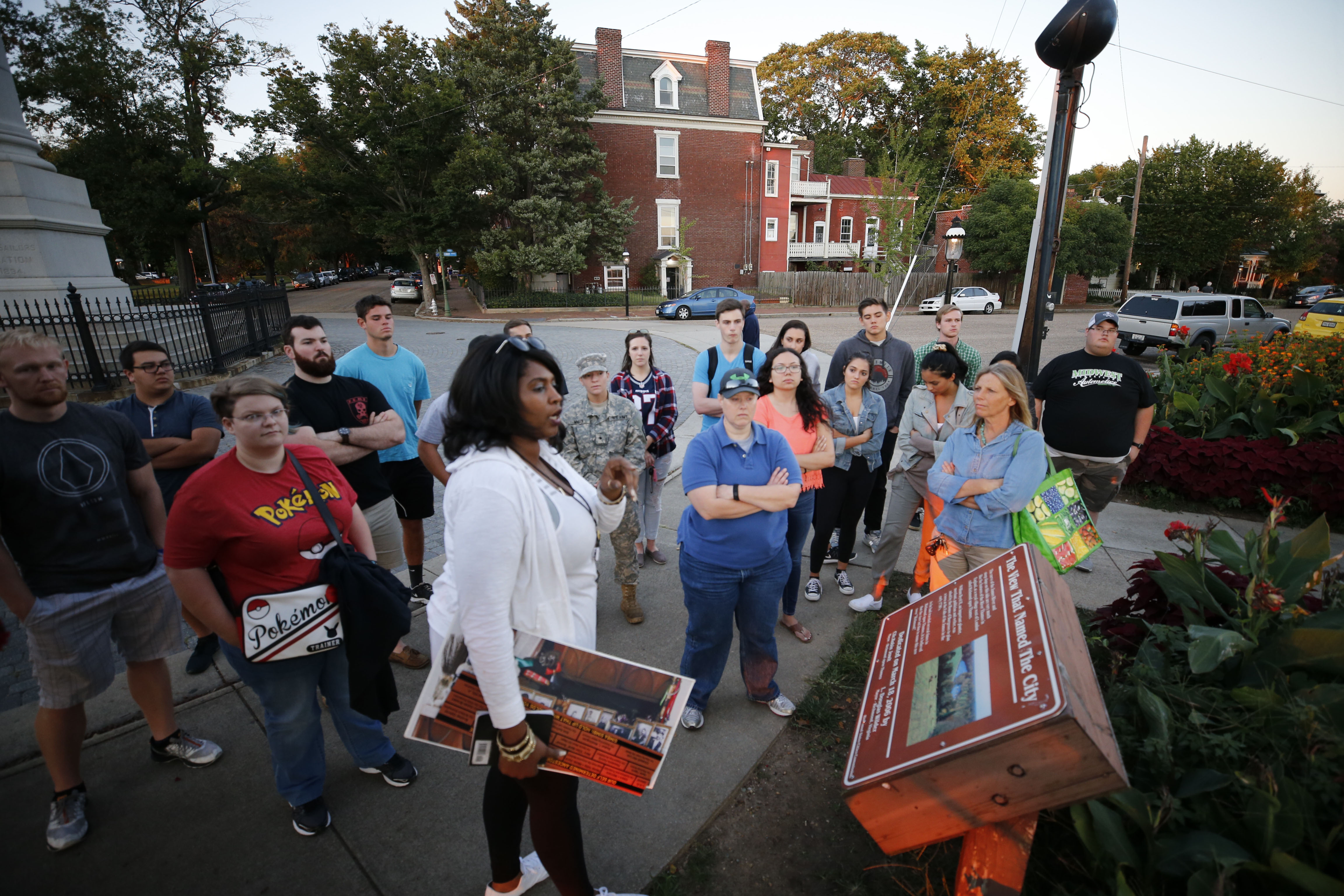 Located just 1.4 miles from the Monroe Park campus, Libby Hill Park sits high above the James River in the southern edge of Richmond’s first neighborhood, Church Hill, and offers one of the most striking panoramas of the River City.
Located just 1.4 miles from the Monroe Park campus, Libby Hill Park sits high above the James River in the southern edge of Richmond’s first neighborhood, Church Hill, and offers one of the most striking panoramas of the River City.
According to legend, it was 1730 when an English aristocrat named William Byrd II first stood atop this perch. Inspired by the resemblance between Libby Hill and the surrounding area just west of London known as the River Thames upon Richmond, Byrd is said to have named the new town Richmond.
These are quaint grounds at first glance—a serene greenspace ideal for courtship and contemplation. In fact, this evening the class is joined by two couples: an adolescent pair enjoying the sunset and a newlywed couple still dressed in their wedding clothes being photographed against the sweeping view.
As the students wait for the tour to begin, some splinter off to observe prominent landmarks in the cityscape. A few gesture toward the Lucky Strike Building and Rocketts Landing. Both attractions are especially pronounced against the darkening sky.
Soon Egunfemi joins the group, opening with a directional orientation of the park and the surrounding area.
"Why would anyone erect a statue in the most visible part of the city nearly 30 years after the conclusion of the Civil War in a park that was not associated with combat? It was a concerted effort to rebuild slavery through the assertion of white supremacy."--Free Egunfemi
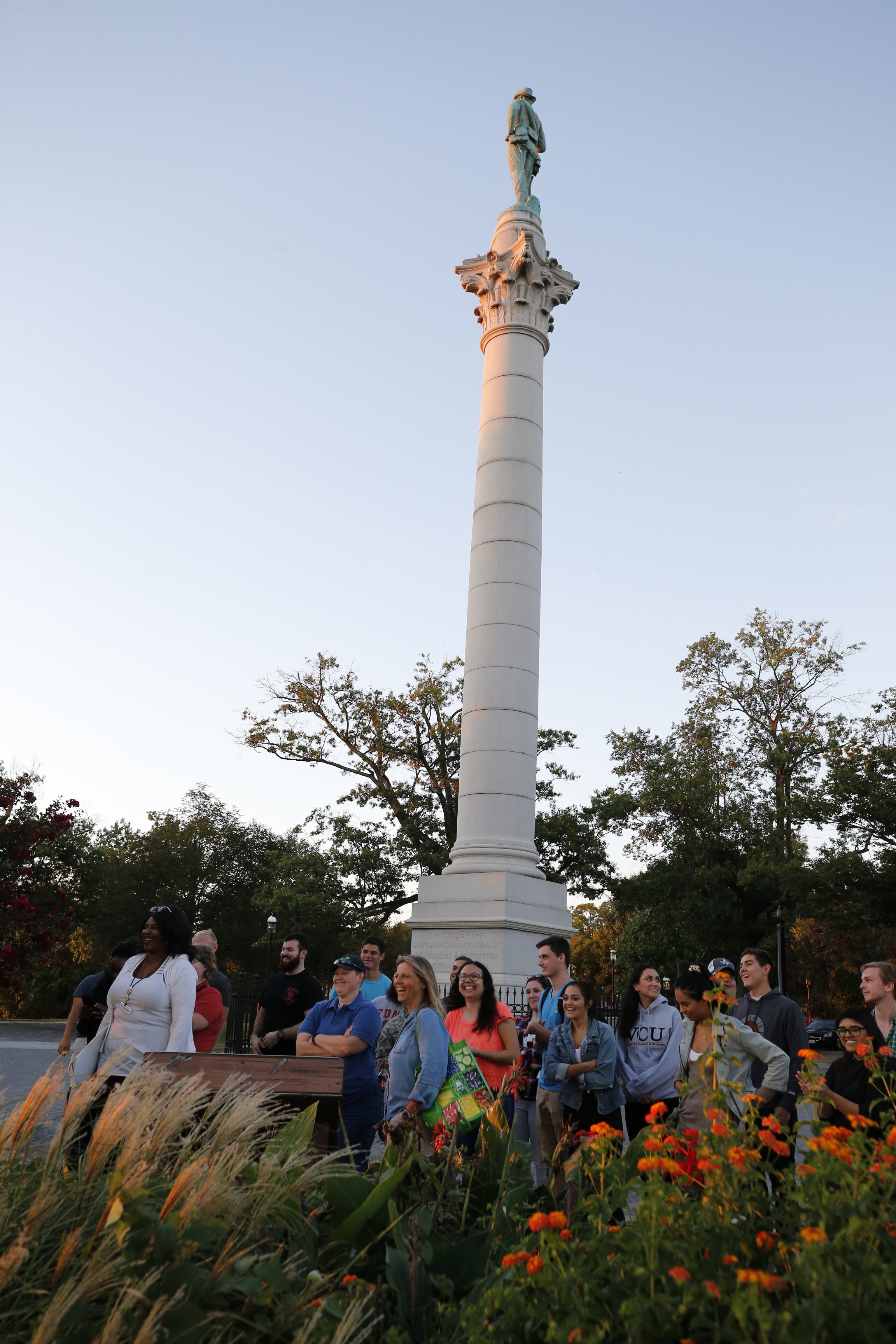
“Directly beneath us are the sacred burial grounds of First Nation Peoples. But, you’ll find no placards to mark the spot, because the historical narrative is a reflection of the dominant culture.
“To the right,” said Egunfemi, signaling toward the port of Manchester along the James River, “is the port where Africans who were enslaved and brought to Richmond would have first touched American soil.”
In the massive down-river slave trade, Richmond’s central location to rail and water transportation made it the second largest trading hub of enslaved Africans on the east coast from 1830 to 1860.
“Situated behind us, atop a granite column is the Confederate Soldier and Sailors Monument, a bronze statue of that reaches 86 feet high. It was dedicated in 1894 by a a small association handpicked by a Confedrate veteran who was also the city's principal planner," said Egunfemi.
“Why would anyone erect a statue in the most visible part of the city nearly 30 years after the conclusion of Civil War in a park that was not associated with combat?” she asked. “It was a concerted effort to rebuild slavery through the assertion of white supremacy over black Americans."
Egunfemi’s words offer a sharp contrast to the hill’s beatific vistas, bringing into focus a discomfiting perspective on the history of the city.
When most Richmonders visit Libby Hill Park, they do so with an abstract understanding of the legacy of bondage that permeates this landscape. But the history of Libby Hill—like so many of the city’s structures and places—is full of connections to slavery.
Over the next two hours, Egunfemi leads Moslow-Benway’s class on an eye-opening journey to reveal those ties. Her mission: to disabuse the public of any romantic illusions they may harbor about enslavement.
The Devil’s Half Acre and The African Ancestral Burial Ground
Our next stop is the Devil’s Half Acre in Shockoe Bottom.
Razed sometime in the 1870s and rediscovered by archaeologists in 2006, the Devil’s Half Acre was a notorious pen owned by slave broker Robert Lumpkin.
In relating the life and deeds of Lumpkin, Egunfemi is as far away from the sentimental portrayal of a peaceful coexistence between a paternalist master and his slaves as any narrative will allow.
In the two decades preceding the Civil War, Robert Lumpkin was the largest slave trader in the city of Richmond. An estimated 30,000 men, women and children were sold from his auction block between 1840 and 1862.
Before they were sold, however, most of those people lived in a two-story den that contemporaries knew as Lumpkin’s Jail.
So deplorable were the coup-like conditions and the unusual 'whipping room' outfitted especially for torture that the facility became known as the “Devil’s Half Acre.” Legend has it that the mere mention of the place could send slaves into panic.
In numerous accounts, Lumpkin is described as a man with an appetite for cruelty. In “Wicked Richmond,” historian Beth Brown portrayed him as a figure who would “often observe beatings at the whipping room and return home for a pleasant meal, the wails of the punished still carrying upward to the window” of his home that lay adjacent to the pen.
Like many of his time, Lumpkin’s penchant for racial hatred was no match for his hypocrisy. The successful slaver would eventually marry his slave, a woman whom he named Mary. That union resulted in five children.
When he died shortly after the war in 1866—Lumpkin's wife, Mary Lumpkin, inherited the property.
The tale that follows is perhaps the most evocative account that the class will hear this evening and Egunfemi seems pleased to relay it.
Mary Lumpkin ceded her inheritance to a Baptist minister named Nathaniel Colver. Colver, a Boston native, was looking for a site where he could establish a school for former slaves and the widower Lumpkin was happy to oblige.
"Colver’s school remains today, though it has moved to larger grounds and is now known as Virginia Union University," she said.
In a strange twist of fate, Robert Lumpkin’s wicked compound became the foundation of an educational institution that produced a myriad of African-American change agents, including Governor L. Douglas Wilder and famed civil rights attorney Spottswood W. Robinson III.
The last stop on Egunfemi’s tour, Richmond’s African Ancestral Burial Grounds, is adjacent to the Lumpkin property. And, as the class soon learns, the history of this hallowed ground is as long and complicated as the lives it contains.
Between 1750 and 1816, dead Africans—free and enslaved—were buried here. The Burial Ground for Negroes, as it was then known, was also the site of the execution of Gabriel Prosser.
According to historians, the exact location of the burial grounds is not known though it is believed to have been situated somewhere near the modern intersection of 15th and Broad streets and Interstate 95, on a steep hillside descending down to the once-exposed Shockoe Creek.
Never a desirable location, the burial grounds were susceptible to frequent flooding that produced untold horrors over the years.
By 1806, the cemetery had become the site of the city gallows where convicts were publicly hung. This drew the ire of many of the city’s black residents, who began mobilizing for the creation of a new cemetery.
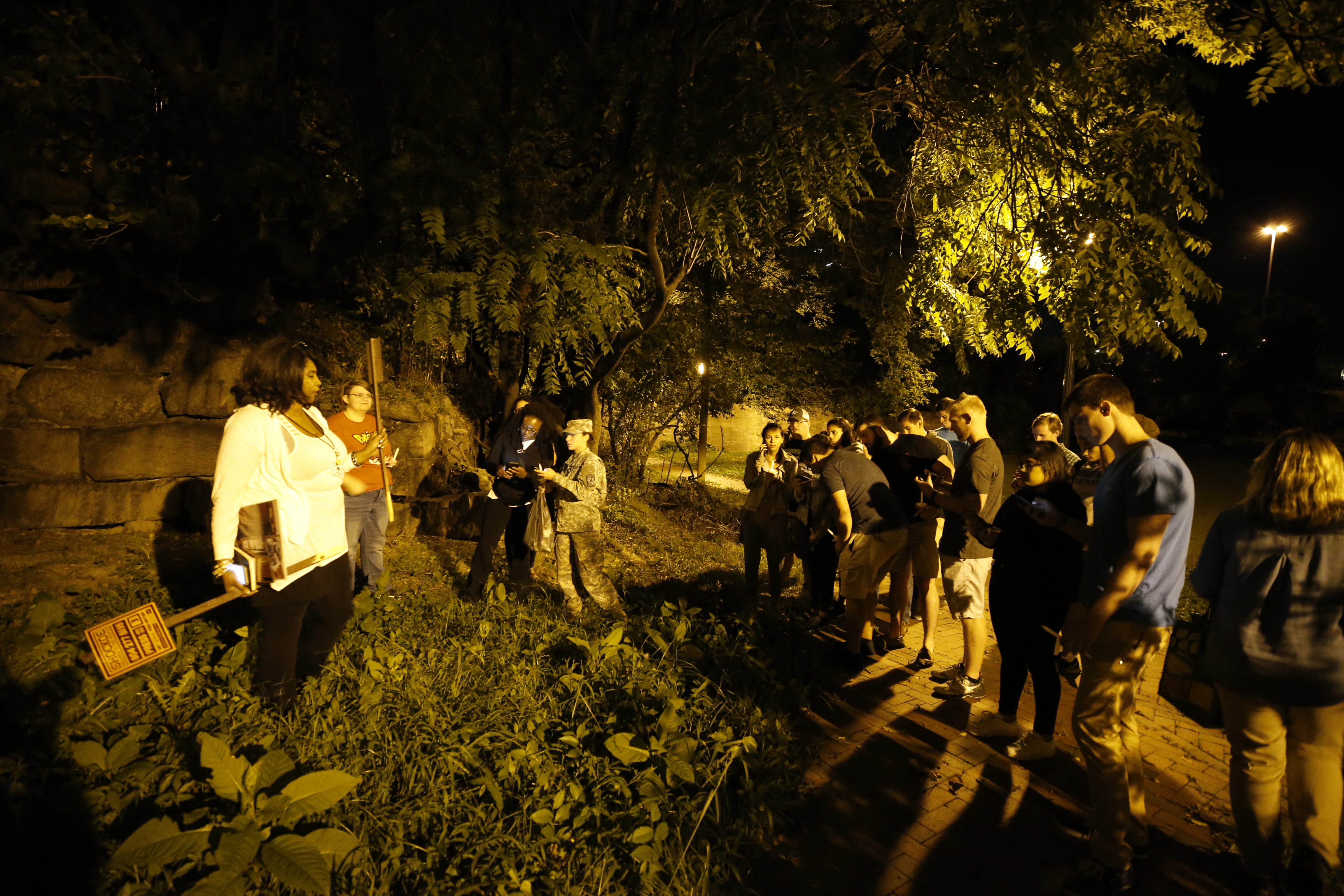
In 1815, free blacks organized to build a private cemetery on the north side of town and by the following year, the city relented and opened a public cemetery for blacks in Shockoe Hill.
The formation of the two new cemeteries led to the effective abandonment of the Burial Ground for Negroes, which soon fell into complete disrepair. In the 1930s, it became the site of a dog pound. And by the 1970s, it was an asphalt parking lot that eventually came under the ownership of VCU.
In 2011, ownership of the African Ancestral Burial Grounds was ceded to the Virginia Trail Commission. Since then, efforts to reclaim the land have been stymied by political and economic development considerations.
Although both the class and Egunfemi have appeared impervious up until this point, it is here that the absence of a publicly funded commemorative effort is most clearly and perceptibly felt.
An estimated 300,000 bodies were deposited here. But there is no bronze monument to commemorate the lives of the Africans who razed the city’s seven hills.
Instead, Egunfemi has adopted the land as her own. With money raised from tours like the one she is leading on this particular evening, Egunfemi cares for the land, cleaning it with the help of volunteers.
“Several times a year,” said Egunfemi, “I pay for these grounds to be mowed.”
Egunfemi’s own mother rests here. When she died in 2014, Egunfemi had her ashes deposited in the cavern of a tree.
One of the biggest student take-aways is that history isn’t something to be observed passively—we can deepen our engagement with the evidence of the past in new ways that enhance our approach to contemporary problems." -Maureen Moslow-Benway
But if the space is personal to Egunfemi, she has also worked to share it with the public.
Using “tactical urbanism,” a practice that involves using low-cost “interruptions” to enhance the well-being of communities, Egunfemi has placed naturalistic installations known as pod-markers throughout the grounds “to tell the story of the oppressed and to mitigate the dominant narrative.”
Egunfemi’s pod-markers can be found throughout the city’s commemorative landscape, but it is here in the African Ancestral Burial Grounds that Moslow-Benway’s class first encounters them.
Through signage and a podcast style message, the class pauses to hear the history behind one pod-marker through a specially curated “story of self-determination, resistance and intersectionality.”
This evening, the students call the number listed on pod, dial an extension and listen to an animated retelling of the life of Gabriel Prosser. One of the most famous slaves in the city’s history, Prosser was a blacksmith who organized a slave rebellion in 1800 that included a plan to kidnap the governor.
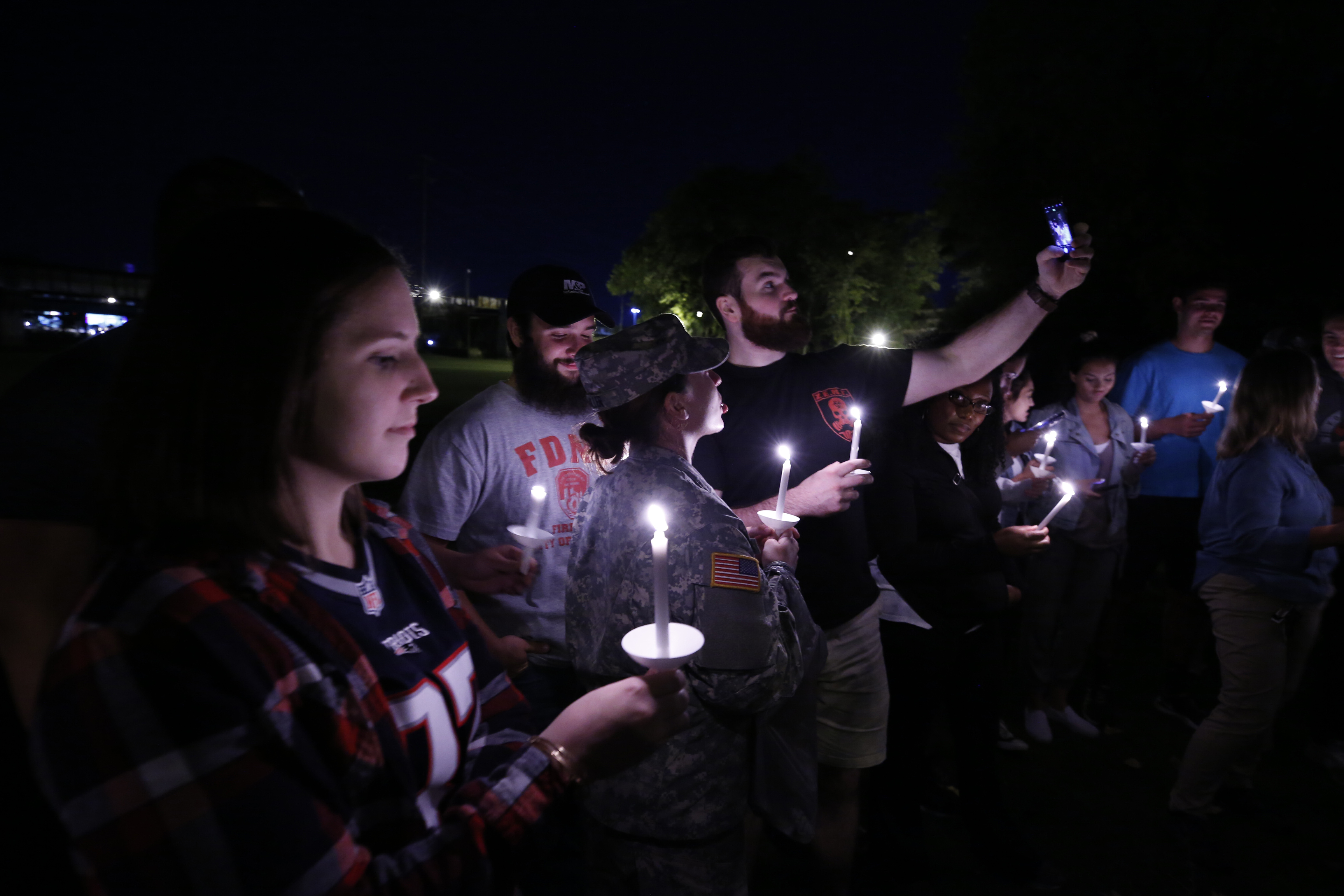
When the class concludes its listening, each person lights a candle to commemorate the lives of the ancestors who rest here. Then, Egunfemi hands everyone a slip of paper with the name of an enslaved ancestor recovered through documentation.
One by one, the members of the class attach their assigned ancestor to the bark of a nearby tree.
“Never forget that you participated in this exercise," said Egunfemi.
"Never forget that that you are connected, that we are all connected to the pain, and the joy and the suffering of those who came before us.”
More than a Field Trip
When the tour ends at 9:30 that evening, Egunfemi is flocked by a handful students. They are stunned, it seems, by her selfless dedication to the African Ancestral Burial Grounds and by the untold histories they now carry.
“This is something that I want people to know. I feel like I want to share this with someone, a friend, a boyfriend,” said Daniela Castro.
For senior Jordan Sumpter, the similarities between Richmond’s enslaved ancestors—many of whom remain unacknowledged by historical markers—and today’s sex trafficking victims seem perilously close.
“We live an era of self-satisfaction,” said Sumpter.
“We tell ourselves that human exploitation is a third-world problem, an issue that was dealt with eons ago. But, it’s happening right here in our backyards…just like it did 200 years ago.”
For Moslow-Benway, the exercise has been a success.
“There’s a lot to talk about and process. I think one of the biggest student take-aways is that history isn’t something to be observed passively—we can deepen our engagement with the evidence of the past in new ways that enhance our approach to contemporary problems.”